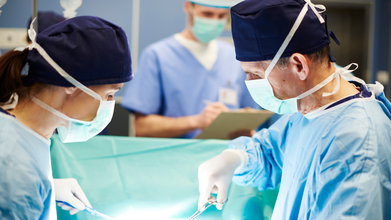- Health Conditions A-Z
- Health & Wellness
- Nutrition
- Fitness
- Health News
- Ayurveda
- Videos
- Medicine A-Z
- Parenting
- Web Stories
71-Year-Old Declared Dead, But Came Back Alive: How Science Explains This Shocking Revival

(Credit-Canva)
As we grow old, it is said that our balance and stability decreases, and the chances of us falling and injuring ourselves is much more prevalent. It was just another day in the emergency room when a 71-year-old was admitted after cranial and thoracic trauma from a fall. He was a bit confused and struggling to catch his breath, but the team was optimistic. They began the standard workup, expecting to stabilize him for further evaluation.

However, the treatment was derailed when he suddenly experienced a cardiorespiratory arrest. The emergency room staff-initiated CPR, following the strict protocols of Advanced Life Support. They checked for cardiac tamponade, a potential cause, but the bedside ultrasound showed nothing. Despite receiving CPR for 20 minutes, his heart didn't respond. He was declared dead. About one minute later, however, his heart began beating on its own, and he ‘rose from the dead’. He still couldn't breathe on his own and was moved to the ICU.
Also Read: Loni Anderson Dies Day Before Her 80th Birthday: Remembering Her Crusade Against COPD
Although he was stabilized, the man eventually died. His injuries included bleeding in the brain, fractures to his skull, neck, and ribs. This report was published in the International Journal of Innovative Research in Medical Science, detailing a case of Lazarus phenomenon that happened in February of 2025.
Rising From the Dead – Not A Miracle But Medical Phenomenon
When an emergency situation arises and we must rush to the doctors, they try their level best to ensure that the person receiving the care survives and has the best possible quality of life. However, it is not always possible. So, it is nothing short of a miracle when a person comes back to life, after some period of being declared dead. This is called the Lazarus Syndrome. It is a rare event where a person's heart spontaneously starts beating again after they've been pronounced dead following a failed CPR attempt, it was named after the biblical figure Lazarus.
The International Journal of Community Medicine and Public Health 2024 review explains that even though it has been documented in medical literature, doctors don't fully understand why the Lazarus syndrome happens. Several theories have been proposed. Sometimes, the drugs given during CPR might not work right away. The heart could restart when the medication finally takes effect. Some possible theories suggested by the:
Delayed Medication Effect
Sometimes, drugs given during CPR might not work right away. The heart could restart when the medication finally takes effect.
Hyperkalemia
An excess of potassium in the bloodstream may play a role.
Myocardial Stunning
This refers to a temporary loss of heart function that can improve on its own.
Reperfusion Injury
When blood flow returns to the heart after a period of being stopped, it can sometimes cause further damage.
Is It Medical Negligence Or An Unavoidable Phenomenon?
To understand this, a 2012 survey published in the Critical Care Medicine, asked doctors what methods they used to declare a patient dead. Out of 501 intensive care doctors in Canada, 49% responded to a survey about how they determine death after a patient's heart stops. The doctors had an average of 10 years of experience and typically worked in large, university-affiliated hospitals.
The survey revealed a lot of variation in how doctors declare a patient dead. The most common methods were listening for heart and breath sounds and checking for a pulse, but no single method was used by everyone. Despite the variations, many doctors agreed on a few key points:
Lazarus Phenomenon
65% of the doctors believe that autoresuscitation, or the Lazarus phenomenon, is real, with 37% saying they have personally seen a possible case during their career.
Need for Guidelines
A large majority of doctors (69%) believe there needs to be a standardized process for declaring death after a cardiac arrest. This number was even higher (91%) when it came to cases involving organ donation.
How Does The Lazarus Phenomenon Change Medical Care?
The 2024 review of Lazarus syndrome details how the syndrome forces us to rethink what it means to be alive or dead. It raises difficult questions, such as:
- When is someone really dead? It makes doctors re-examine the rules for declaring death.
- What about organ donation? If a patient could potentially come back to life, it complicates the process of organ donation.
- What if they survive with brain damage? Doctors and families must consider the patient's potential quality of life if they recover but have suffered brain injury.
How Do the Doctors Deal With Lazarus Syndrome?
To understand the effects of Lazarus syndrome, the medical team’s main goal is to figure out what caused it and to give the appropriate treatment. They might use advanced cardiac life support, which means giving the highest level of care possible.
Doctors might also use a special machine called extracorporeal membrane oxygenation (ECMO) to help the heart and lungs work.
Another treatment option is therapeutic hypothermia, where the patient's body is cooled down to help protect their brain from damage.
Ultimately, we still have a lot to learn about this rare event, and more research is needed to better understand how to manage it.
Breast Cancer Awareness Month: Nutritionist Reveals 6 Foods That May Lower Breast Cancer Risk

Credits: Canva
October is Breast Cancer Awareness Month, making it the perfect time to focus on habits that can help protect your health. While no single food can guarantee prevention, research shows that certain nutrients and antioxidants found in everyday foods may play a role in reducing the risk of breast cancer. For women, especially those with risk factors, incorporating these foods into your diet can be a meaningful step toward prevention.
Understanding Breast Cancer
Breast cancer occurs when breast cells start to grow abnormally and form tumours. If these tumours are not treated, they can spread to other parts of the body and become life-threatening. According to the World Health Organization (WHO), this disease claimed an estimated 670,000 lives worldwide in 2022. In India, breast cancer is also increasing, with one in 28 women now at risk. This makes it all the more important to understand ways to lower risk through lifestyle and dietary choices.
6 Foods To Prevent Breast Cancer
Nutritionist and weight loss specialist Leema Mahajan took to her Instagram to highlight the power of food in breast cancer prevention. She emphasizes starting early: “Introducing these foods into your diet from a young age can help reduce your chances of developing this disease later in life.” Mahajan identifies six key foods backed by research for their potential protective benefits.
1. Pomegranate
Pomegranates are rich in compounds called ellagitannins, which studies suggest may help slow down the growth of cancer cells and limit estrogen-driven tumour development. Mahajan recommends enjoying one cup of fresh pomegranate each day. “Fresh pomegranate seeds can support your body’s fight against abnormal cell growth. It’s simple, delicious, and effective,” she says.
2. Cruciferous Vegetables
Vegetables like broccoli, cauliflower, cabbage, and Brussels sprouts belong to the cruciferous family, known for their cancer-fighting properties. These vegetables contain sulforaphane, a compound that aids the liver in breaking down harmful estrogen by-products and may help prevent tumour formation. Mahajan advises, “Include cruciferous vegetables in your meals three to four times a week. You can eat them raw in salads or lightly steamed to retain their nutrients.”
3. Berries
Berries such as blueberries, strawberries, and raspberries are packed with antioxidants, particularly anthocyanins, which help combat cell damage and inflammation. Adding a handful of berries to your breakfast or as a snack is a tasty and nutritious way to support your body’s natural defenses.
4. Fatty Fish
Omega-3 fatty acids found in salmon, mackerel, and sardines may have anti-inflammatory properties that reduce cancer risk. Including fatty fish two to three times a week can support overall health and may help maintain hormone balance.
5. Green Tea
Green tea contains polyphenols, which have been shown to slow cancer cell growth in laboratory studies. Drinking two to three cups daily can be a simple, comforting habit with potential protective benefits.
6. Tomatoes
Tomatoes are rich in lycopene, an antioxidant linked to lower cancer risk. Cooking tomatoes, such as in sauces or soups, makes lycopene more easily absorbed by the body.
Small Changes, Big Impact
Incorporating these foods into your daily meals isn’t just about prevention, it’s also about building a sustainable, healthful lifestyle. While diet alone cannot prevent breast cancer, combining these nutritious foods with regular exercise, adequate sleep, and routine medical screenings can strengthen overall health and reduce long-term risk.
Eating with awareness, enjoying colorful fruits and vegetables, and making consistent, balanced choices can empower women to take charge of their health, one meal at a time.
Cancer Risk May Increase Depending On Where You Carry Fat: Study Links Excess Fat In This Part Of Body To Cancer

(Credit-Canva)
New research suggests that the common way doctors measure a healthy weight, called Body Mass Index (BMI), may not be the best tool for figuring out a person's risk for cancer. Instead, the study found that where a person carries their extra fat, especially fat around the stomach, is a much more important clue.
A new study published in the Journal of the National Cancer Institute, found that belly fat plays a big role, not just in our general health but also in cancer. However, how does fat around your mid-section define this?
Where Your Fat Sits May Be Key
For many years, doctors have used BMI (which is calculated from your height and weight) to see if someone is overweight or obese and then use that status to estimate their risk for various cancers. However, this new study found that relying only on BMI is too basic. The research suggests that the location of extra fat on your body might be just as important, if not more so, in deciding whether your risk of developing several types of cancer goes up or down.
How Belly Fat Increases Risk Of Cancer
The study used advanced methods to look at the relationship between fat in five different areas of the body and the risk for 12 common cancers linked to being overweight. The clearest and most alarming finding was that fat around the abdomen (belly fat) was the most dangerous type of fat:
Increased Risk
Belly fat was directly linked to a higher chance of developing three specific cancers: endometrial cancer (of the uterus), esophageal cancer (in the food pipe), and liver cancer.
Worse Health Marker
Doctors pointed out that carrying fat in the center of your body is already known to cause problems like diabetes and heart disease. They believe this is because central fat causes a lot of inflammation inside the body, and this inflammation is what can actually encourage cancer to grow.
Are There Benefits Of Having Belly Fat?
While fat around the stomach was dangerous, the researchers made a surprising discovery about lower body fat. They found that fat carried in the buttocks and thighs actually seemed to help protect against cancer. This fat was linked to a reduced risk of both breast cancer and a type of brain tumor called meningioma. This unexpected result has led some experts to think that the fat cells in the lower body might produce helpful hormones that fight against cancer.
Why BMI Isn't Enough
This research strongly confirms that doctors shouldn't just rely on the single BMI number. As one cancer doctor noted, BMI is a "quick and dirty" measurement that only gives a very basic picture of your health; the location of excess fat matters much more. Scientists believe fat increases cancer risk in a few ways, including:
- Producing extra hormones like estrogen and insulin, which are known to fuel the growth of many cancer types.
- Creating a state of chronic inflammation in the body, which helps tumors get started and grow.
The study concludes that future health plans, both for treating obesity and preventing cancer, should focus on measuring and managing where fat is distributed rather than just focusing on overall weight. While losing weight is still beneficial, the body part where the fat is concentrated is a powerful indicator of risk.
First Kidney Transplant With Universal Blood Type Performed: Here's How Scientists Achieved This

(Credit-Canva)
There are many aspects of an organ donation, not just the need for an organ, but also how compatible it is in terms of blood type. The reason why this is important is because of components known as antigens. The recipient's own body can destroy the new organ if the donated organ has different antigens. However, scientists may have found a way to surpass this issue.
A major scientific breakthrough has occurred: scientists successfully changed the blood type of a donated kidney using a special enzyme and then transplanted it into a patient. This is the first procedure of its kind. Right now, a patient can only receive an organ if the donor has a compatible blood type. If the types don't match, the patient's immune system will immediately produce antibodies or immune soldiers to attack and destroy the foreign organ.
How Did The Mismatched Blood Type Transplant Work?
The research team from Canada and China found a special enzyme that can remove the Type A antigens from an organ. Antigens are the markers on blood cells (and organs) that determine blood type. By removing the Type A markers, the enzyme essentially converts Type A blood into Type O blood.
Type O is considered the "universal" donor type because anyone can receive it. In this first test, the converted Type O kidney was transplanted into a 68-year-old patient. Although the kidney eventually showed signs of rejection after two days, it was able to function and produce urine for six days, proving the concept works.
How Does A Universal Kidney Work?
If doctors can successfully change the blood type of a donor organ, the current limits on transplants would largely disappear, creating enormous benefits for patients.
Significantly Increased Access to Organs
Without the need to match blood types, doctors wouldn't have to wait for an organ that is both a good match and the correct blood type. Instead, they could focus only on other factors important for the transplant's long-term success. By removing the blood type obstacle, this technology would allow for faster matching and quicker surgeries, which will dramatically reduce the painfully long waiting lists that patients currently face.
Shorter, More Efficient Wait Lists
Without the restriction of matching blood types, doctors wouldn't have to wait for an organ that is both a good match and the correct blood type. Instead, they could focus on other crucial factors, like matching proteins and tissues that are important for the long-term success of the transplant. By eliminating the blood type hurdle, this technology would allow for faster matching and quicker surgeries, drastically reducing the painfully long wait lists that patients currently face for life-saving organs.
Eliminating Risky Pre-Treatment for Recipients
This new approach of treating the donor organ instead of the patient is a major advancement. Right now, to perform a blood-type-mismatched transplant, the patient has to get intense treatments beforehand to severely weaken their immune system. These treatments are risky because they significantly increase the patient's vulnerability to severe infections.
Furthermore, for deceased donor organs—which must be used very quickly—there simply isn't enough time to safely administer these pre-treatments. By converting the organ outside the body, doctors can avoid this high-risk step for the recipient, making the transplant safer and much more feasible for emergency cases.
What Happens Next
This successful first attempt proves the enzyme-conversion technique works, but it's just the beginning. The scientists now need to conduct more studies on both brain-dead and living patients. Their main goal is to figure out the best way to adjust the treatment so that the converted organ can function successfully for a long period, ultimately allowing this revolutionary technique to be used in hospitals everywhere.
© 2024 Bennett, Coleman & Company Limited

